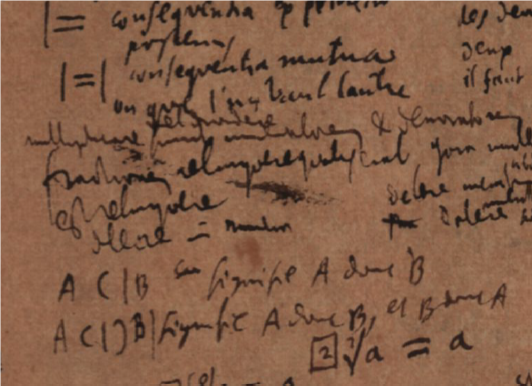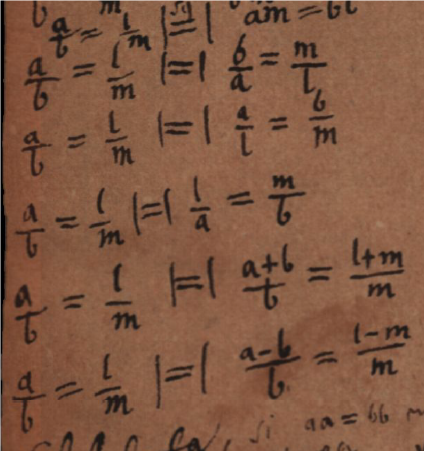Overview of Elemens du calcul
The Elemens du calcul is remarkable for the list of axioms it provides. Compared to the axioms isolated at the end of the 1680s in the calculus coincidentium or later in texts such as Prima calculi magnitudinum elementa, the first striking difference is the sheer number of listed items. Whereas Leibniz usually posits “[latex]a=a[/latex]” as the main axiom (see, for example, Prima calculi magnitudinum elementa, GM VII, 77), and sometimes adds idempotence ([latex]a+a=a[/latex]) to specify logical calculi (A VI, 4, 834 (with commutativity) and 848 (with “[latex]a-a=0[/latex]”)), here he proposes a list of no less than 15 axioms and one “demand”. Moreover, this list is very similar to the one we would nowadays provide for the characterization of a number field (to which Leibniz adds rules for exponentiation).
The first two axioms are the usual one characterizing the reflexivity of equality and the rule of substitution. This is Leibniz’s favorite characterization of equality. As he was well aware, one can demonstrate on this basis the other usual properties of equality: transitivity and symmetry (see A VI, 4, 831, prop. 1 and 3). This is what he does in fol. 7r, which presents the “propositions” deriving from our list of axioms. Then he characterizes addition by the following properties: commutativity (item (3) [latex]a+b=b+a[/latex]), invertibility (item (4) [latex]a-a=0[/latex]) and the fact that zero acts as neutral element (item (5) [latex]0+a=a[/latex]). He then does the same with multiplication describing commutativity (item (6) [latex]ab=ba[/latex]), invertibility (item (11) : [latex]\frac{a}{a}=1[/latex], considering, as expressed in item (12), that [latex]\frac{a}{a}[/latex] is a notation for than [latex]a\cdot\frac{1}{a}[/latex]) and the fact that 1 acts as a neutral element ([latex]1\cdot a=a[/latex]). Finally, he also specifies the property of distributivity of multiplication over addition (item (10): [latex]ab+c=ab+ac[/latex]).
This terminology is, of course, anachronistic and one could doubt, in particular, that Leibniz had a clear view of the role of “inverse” elements. A few remarks are therefore in order to motivate a comparison. Firstly, it can be seen that the property [latex]a\cdot\frac{1}{a}=1[/latex] is proved in fol. 7r (Elemens du calcul ordinaire. Propositions) by the simple conjunction of axioms 11 and 12. This was supposed to be proposition III, then transformed into IV and then rewritten (without change) as prop. V : “[latex]a\cdot\frac{1}{a}=1[/latex] Dem: [latex]a\cdot\frac{1}{a}=[/latex] (per ax. 12) [latex]\frac{a}{a}=[/latex] (per ax. 11) 1”(LH 35 4 12 Bl. 7r). More importantly, maybe, it can be noted that division is not introduced in our text as an operation sua generis. In the first part of the manuscript, explaining the definitions (called “Significations”), division is defined as a number, noted [latex]\frac{a}{b}[/latex], which, when multiplied by b, gives a (and, in the same way, subtraction is defined as a number, noted [latex]a-b[/latex], which, when added to b gives a). This contrasts starkly with other texts, such as the Prima calculi magnitudinum elementa, in which Leibniz defines subtraction (more rarely division) as the operation of taking away something (logical calculus itself is sometimes called “plus and minus calculus“).
The only axiom that appears to be missing for us would be associativity. This was certainly the conclusion drawn by Frege when looking in Leibniz for an “analytical proof” of elementary number statements such as “[latex]2+2=4[/latex]” (Grundlagen der Arithmetik (1884) § 6). Yet the reason this axiom is missing is that it appears in the definition as a rule for the use of parentheses: “[latex]a+b+c[/latex] est autant qu’ [latex](a+b)+c[/latex], ou qu’ [latex]a+(b+c)[/latex] et abc est autant qu’ (ab)c ou qu’ a(bc)” (item (10) in “Significations”). Interestingly enough, Leibniz thought of positing this as an axiom. In the version sketched in fol. 11-12, he first writes two axioms listed 13 and 14 stating that: [latex]a+b+c=(a+b)+c[/latex] and [latex]abc=(ab)c[/latex], before changing his mind and putting it as a characterization of the use of parentheses in fol. 1.

The same could be said about the fact that Leibniz did not specify that [latex]\frac{1}{a}[/latex] exists only when a is supposed to be different from 0. When one looks at the other documents, one sees that this was supposed to be specified later, as a proposition (see, for examples, LH 35, 4, 12, fol. 7r : “[latex]\frac{a}{0}[/latex] est une absurdité”). Indeed, for reasons we cannot detail here, Leibniz considered that this was true not in full generality, but “only if a is not 0”. As explained in a scholium on fol. 7r, this was related to the fact that the expression [latex]\frac{0}{0}[/latex] may appear in Differential Calculus where, under some specific conditions, it can have a meaning (See. S. Bella, “De l’intraitable à l’indéterminé : entre calcul et géométrie, réflexions leibniziennes autour de [latex]\frac{0}{0}[/latex] (1700-1705)”, to appear in Philosophia Scientiae, June 2021).
The comparison with other attempts such as that of Prima calculi or of Mathesis generalis immediately shows that some statements, which are axioms here are theorems there. For example, as stated in Mathesis generalis, “[latex]a-a=0[/latex]” can be derived from the definition of subtraction. More interesting maybe, this is also the case in our text. But this should be no surprise: Leibniz always claimed that mathematical axioms are demonstrable (from the one and only genuine axiom, i.e. the principle of identity, and definitions). It should be noted, in passing, that this is another way of saying, in a view which is often ascribed to the turning point of the 19th century, that axioms (except identities) are definitions in disguise. The definition of subtraction in our text is that the sign “[latex]a-b[/latex]” signifies a number such that when it is added to b it gives a. Henceforth, since [latex](x-a)[/latex] is defined as the number giving x when added to a, one has [latex](x-a)+a=a[/latex], if and only if [latex]x=a[/latex]. By axiom 5, we have [latex]a=0+a[/latex] and henceforth [latex](a-a)+a=a=0+a[/latex], and finally [latex]a-a=0[/latex]. As can be seen in this example, axioms do not act here as “logical” foundations, but as a way to characterize the “calculus magnitudinum” as a structure. It is all the more impressive that Leibniz precisely chose the properties we would also consider as characteristic of a field (in this case, of magnitudes).
Another quite remarkable feature of this text is the introduction of logical signs as primitive. They appear in a corner of fol. 11v as a way of marking consequentia and the fact that it can be symmetrized in the case of what we would call logical equivalences.

In fol. 6v, Leibniz even proposes introducing two different signs: one for consequentia (and consequentia mutua) and one for inferences (If A then B).

The context is a series of algebraic identities one can derive from the axioms by using substitution and the fact that most of them are “if and only if” conditions:

In the fragment called “Propositions” (fol. 7r and v), he simply remarks in passing that all these propositions are “convertibles”, a fact he announces that he will develop in more detail later. But in this latter text we can witness another interesting development: these reflections are put under the heading of the treatment of “formulae” (in this case the fact that “deux grandeurs sont égales quand les formules qui les experiment ne different que par deux grandeurs ingredientes égales”). Leibniz then introduces symbols for formulae (capital letters) and for magnitudes (small letters), in order to indicate the compatibility of mathematical equality with logical equality through substitution (what we would call a “congruence”). This constitutes the climax of a “logical” approach to mathematics, which Leibniz announced in the first texts on mathesis universalis as a Logica mathematica, conceived as a logic of mathematics (see Leibniz (2018), text [3b] and Michel-Pajus & Rabouin (2017)).
